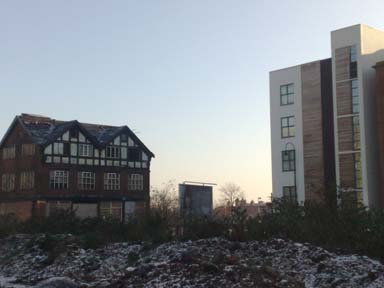A different side to regeneration
Article published: Friday, May 1st 2009
A walk through East Manchester is never dull. At each turn, layers of history mingle: huge mills and canals from the industrial revolution, 1930s red-brick terraces, tower blocks from the great post-war social housing projects. The area entered a lengthy economic decline in the 1980s as Britain de-industrialised. During the past decade, a huge regeneration process has been led by New East Manchester Ltd (NEM), a Public-Private Partnership.
 Ancoats is the gateway to the east of the city. Follow the Rochdale Canal along Old Mill Street, and you’re greeted by a graphic illustration of the contradictions of the regeneration process. On the left, small council houses, many boarded up, with abandoned tower blocks looming behind. To the right, angular, futuristic blocks of expensive flats sprout from the vast building site that is New Islington Millennium Community.
Ancoats is the gateway to the east of the city. Follow the Rochdale Canal along Old Mill Street, and you’re greeted by a graphic illustration of the contradictions of the regeneration process. On the left, small council houses, many boarded up, with abandoned tower blocks looming behind. To the right, angular, futuristic blocks of expensive flats sprout from the vast building site that is New Islington Millennium Community.
A star NEM project, New Islington is led by massive property developer Urban Splash. The scheme, started in 2003, aims to “balance the desire to make profit with the needs of a sustainable community”. Private sector organisations backed the project to the tune of £200 million, with £20 million of public money thrown in for support.
Built on the now-demolished Cardroom council estate, New Islington is fenced by colourful advertising hoardings displaying images of affluent 30-somethings in elegantly furnished apartments, and entreats passersby to “design your own loft space”. Around 200 homes were demolished to make way, their occupants forced out by Compulsory Purchase Orders. So far less than 50 new homes have been built out of the 1700 promised.
Now profits are under threat, the future of the project is uncertain. Some developers are pulling out, with spokespersons saying work will resume “when the market is ready”.
Even now, gushing praise for such projects emanates from Manchester’s great and good. But not everyone’s happy. A vocal critic of regeneration has been community activist Bill Booth from West Clayton, two miles east of the city centre, and within the NEM regeneration area. Bill has lived there for 36 years, spending the last eight campaigning against demolitions while he waits to find out the future of his own red-brick terraced home.
Areas like Clayton suffer from low occupancy and negative equity. Bill’s area consists of 290 homes. More than 115 belong to social landlords or private owners who have kept many properties empty for years, aiming to sell them to the council if demolition takes place. Bill’s Residents Association advocates refurbishments of existing properties, claiming that 80 per cent are structurally sound. This has led to clashes with new-build inclined NEM.
“It really annoys me,” says Bill, “the Labour government think they can steamroller this area. Why replace terraced houses with something that has a 30-year lifespan?” He likens much of the regeneration process to “social cleansing of the working class” because local people haven’t a “cat’s chance in hell” of affording most of the new homes.
Those evicted are offered re-housing elsewhere, but Bill is wary of higher council tax and maintenance fees. And even generous deals will entail loss: “I want to stay in the community that I’ve grown up with. Once that community is smashed and broken apart it will never be regained,” he says.
Outwardly, NEM aims to revitalise communities. Bill disagrees. “It’s all about money. They’ve given big property developers a carte-blanche,” he says. Indeed, the chair of NEM is Robert Hough, who is also executive director of the region’s largest property owner, Peel Holdings.
Or take a project. Holt Town for instance. The 34-hectare, 3,500-home plan cuts through East Manchester, and is explicitly aimed at affluent city-centre dwellers. Cibitas, the consortium driving the project, consists of big property market players, including ING bank, and former Barclays Bank chairman Sir Andrew Buxton.
Speaking to Property Week, Cibitas founder David Shelton said they were “looking for under-performing areas on the fringe of existing vibrant property so we can stretch the market”.
Extending high city-centre property values into poorer outlying districts where land is cheap, and potential profits high. They are building in an area within the two per cent of the most deprived nationwide, where 52 per cent live on benefits. But rather than building cheap homes, Holt Town’s affordable housing strategy involves “extending finance” – meaning debt – to people who find the properties too expensive. Post-subprime crash, risky mortgages are somewhat unfashionable. The fall back option? Building between five and fifteen per cent affordable housing.
Manchester City Council refused to reveal details of the Holt Town development deal, to protect Cibitas’ business interests. Sue Bowen, a community activist with East Manchester Community Forum for around 20 years, was unsurprised at the secrecy. “It’s all primarily based on the market, not people,” she said.
“Councillors sold out. They sold the land very cheaply to private sector developers. There are targets for getting communities involved, but when you see the schemes, they are very much about what the private sector wants.”
Sue agrees a mixed income population in East Manchester is a good idea but feels, like Bill, that NEM haven’t achieved balance.
“People in the area can’t afford the new-builds, and they haven’t given enough social housing back.”
With the housing market collapsing, projects based on attracting wealthy private owners face uncertainty. “No one knows at the moment where things will go,” admits Roz Hughes, NEM press officer. “A lot of property companies are going bust and they have to do what’s best to survive.”
Live by the market, die by the market. Could things have been done differently? Sue and Bill think so.
“Developers came up with a brainwave that if they bring in people with money it will be vibrant again. But these people are not interested in staying long. The place needs to get young people back into employment, and then it will be vibrant,” insists Bill.
Sue thinks there should be greater wealth redistribution, and models that challenge the private sector dogma.
“When a housing developer comes in and makes a lot of money, the government needs to take a bigger cut of their profit – to put into improving public spaces and local employment. You don’t need to have private profit to build houses. If the community owned the land through trusts, you could build good quality houses at affordable rates.”
The regeneration of East Manchester is still relatively young. Whether the process runs in the interests of private profit or social need, will crucially depend on the strength of local communities. The recession brings threats and opportunities. House repossessions will become more frequent, and predatory speculators will seek to pick off remaining properties cheap. But as the market-led approach to regeneration hits the rocks, alternative approaches will find space.
Reflecting back, Bill says the years of struggle have been a tax on his life, but he has hope.
“They forgot that people like me and others will spend the time to stand up and ask awkward questions. They’ve educated us, and they probably educated us a little better than they anticipated. And now it’s coming back at them.”
Andy Bowman
More: Council, Features, Local economy
Comments
No comments found
The comments are closed.



